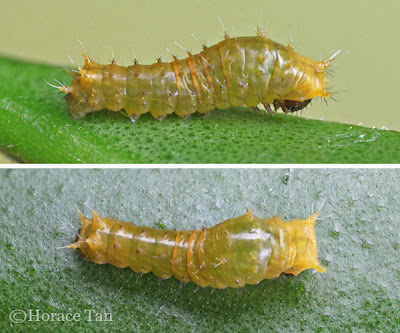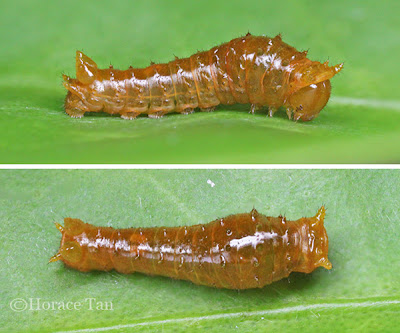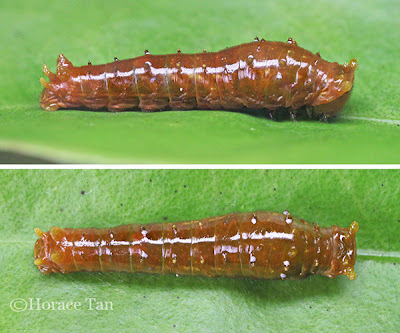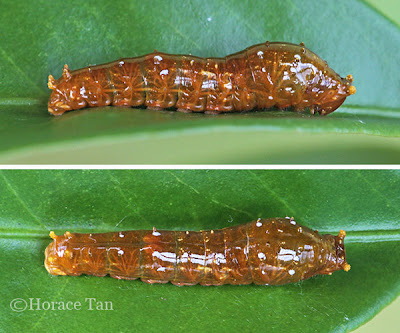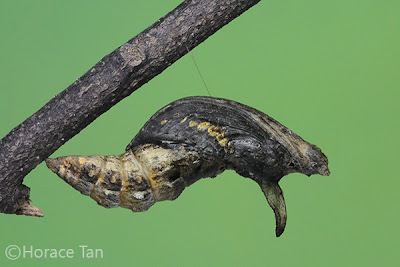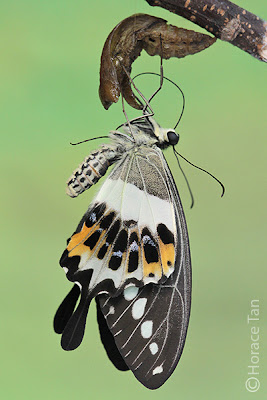The Banded Swallowtail Butterfly
Papilio demolion (Cramer, 1776) |
| Resting Papilio demolion. Credit: Wikipedia Commons |
[1] Introduction
The Banded Swallowtail Butterfly, Papilio demolion, can be commonly found in different parts of Australia and South East Asia, such as Thailand, Indonesia, Philippines, as well as Singapore.[1] It belongs to the genus Papilio. Papilio demolion adults are characterized by a long pale-greenish band that stretches from the forewing's apex to the hindwing's mid dorsum. The hindwing also has a series of similar-coloured lunules and a black tornal spot embedded within a larger orange spot. In Singapore, these butterflies are common in the various nature reserves, wetlands and mangrove habitats.[2]
[2] Morphology
Wing structures and patterns are crucial in the identification of butterflies. The diagrams and photographs below will make it easier for us to better understand the terms which help to describe the Banded Swallowtail Butterfly. |
| Ventral view of Papilio demolion. Credit: Thomas Neubauer |
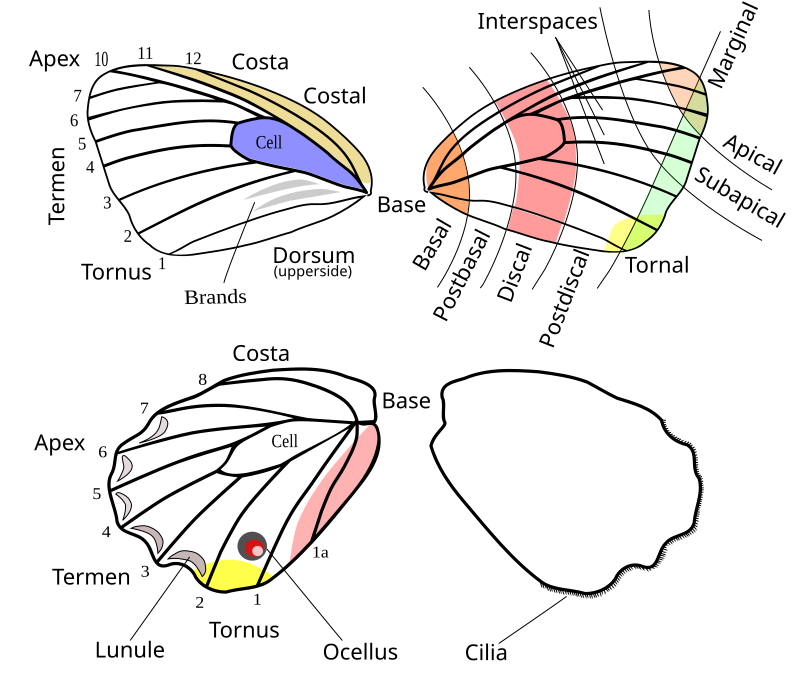 |
| Butterfly wing regions by L. Shyamal. Licensed under CC BY-SA 3.0 via Commons |
The Banded Swallowtail is relatively small in size, with a wingspan of 90 to 100 millimeters.[3] It is easily identified by the yellowish or light greenish band patterns found on both the hindwings and forewings. The lunules are spread across the termen and apex sections of the hindwing. Areas not affected by the band patterns are a deep black colour. The 'swallowtails' protrude around the 3rd and 4th section of the termen.
[2.1] Sexual Dimorphism
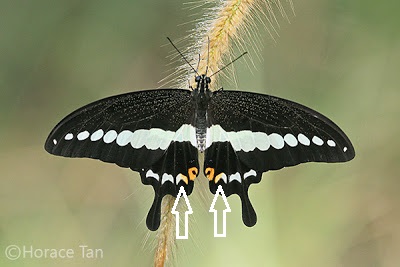 |
| Female Banded Swallowtail. Credit: Horace Tan (Permission Obtained). Edited by Brent Tan |
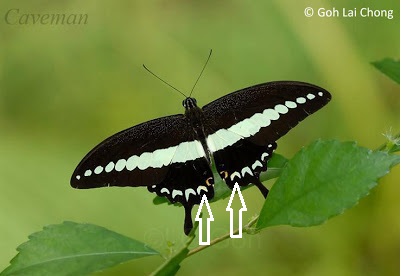 |
| Male Banded Swallowtail. Credit: Goh Lai Chong (Permission Obtained). Edited by Brent Tan |
Looking at the parts which have been pointed out by the white arrows in both of the above photos, we observe that the lunule in space 2 of the top butterfly has an orange tinge while that of the bottom butterfly is completely light green in colour, bearing the same color as the band. The orange tinge is unique to female species.
[3] Life History
[3.1] Host Plants
The Banded Swallowtail butterfly has quite a number of different host plants. Three of its host plants come from the Rutaceae family, and they are, Luvunga crassifolia, Luvunga scandens and Melicope lunu-ankenda.[4] Several species of Lime trees coming from the genus Citrus, are also host plants to the Banded Swallowtail.[5] Similar to most other butterflies, the Banded Swallowtail is holometabolous, having 4 stages in its life cycle: egg, larva, pupa, adult. The host plant is especially crucial for the survival of the butterfly during its larval stage, providing much-needed shelter and food.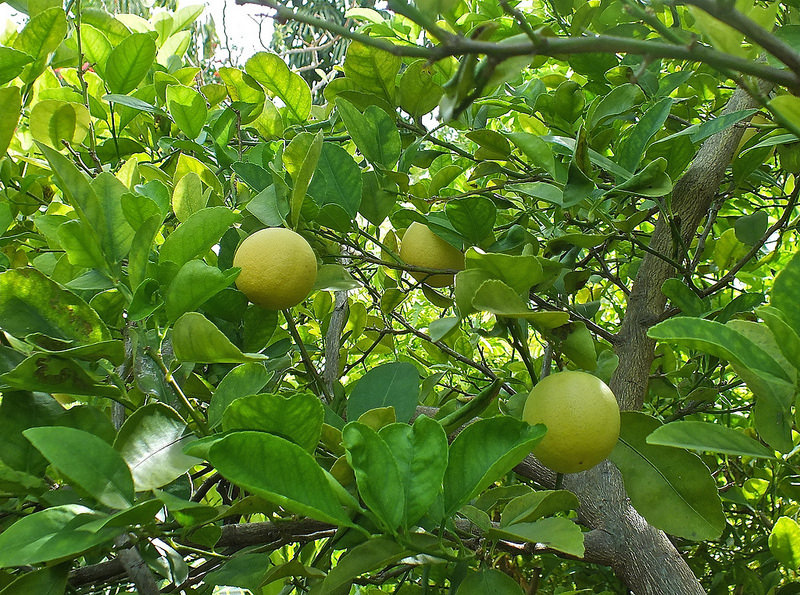 |
| Lime Tree. Credit: The Southwest Florida Store |
[3.2] Development Stages
[4] Ecology And Behaviour
[4.1] Courtship/Mating Habits
Similar to the mating habits of most other butterflies, the female Banded Swallowtail takes the passive role, with the male doing much of the chasing and work. The male flutters and hovers around the female, in the hope of being noticed by the female, and while doing this, he will also release his pheromones to signal to the female his mating intentions.[6] Females generally only mate one or twice in their lifetimes and as such, they are relatively choosy about their partners.[4.2] Feeding Habits
The adult Banded Swallowtail feeds on Lantana and Ixora plants, and the larva feeds on the leaves of the host plants.[7] |
| Banded Swallowtail feeding on Ixora congesta. Credit: The Lazy Botanist Blog (Direct permission not obtained but within the Limits of Fair Use) |
[4.3] Flight Patterns
The pointed wings of the Banded Swallowtail allow it to fly rather swiftly and rapidly, allowing them to have a better chance of escaping from predators.[8] The forewings flutter most rapidly while the hindwings are kept rather still, especially while feeding.[9][5] Distribution
[5.1] Local Distribution/Habitat
In Singapore, these butterflies can be found in various areas such as the Central Catchment Nature Reserve, Bukit Timah Nature Reserve as well as Sungei Buloh Wetland Reserve.[10]Differing from other members of the Swallowtail family, the Banded Swallowtail almost never indulges in 'puddling', a process where butterflies fly close to the ground to suck up any moisture or fluid. This butterfly can be seen flying high above the ground, commonly residing in grassy or swampy mangrove areas.[5.2] Global Distribution
 |
| Banded Swallowtail Global Distribution. Credit: butterflycorner.net |
The shaded portions of the photo above represent the places where the Banded Swallowtail can be found. The butterfly is particularly abundant in parts of South East Asia, such as Myanmar, Vietnam, Thailand, Laos, Singapore and Indonesia, and can also be found in China and India. Australia is also home to this butterfly.
[6] Subspecies of the Banded Swallowtail
According to the Merriam-Webster English dictionary, a subspecies is defined as 'a category in biological classification that ranks immediately below a species and designates a population of a particular geographic region genetically distinguishable from other such populations of the same species and capable of interbreeding successfully with them where its range overlaps theirs.'[11] Going by this definition, the Banded Swallowtail has 2 subspecies, and they are Papilio demolion demolion and Papilio demolion delostenus.[12][6.1] Diagnostic Key
Papilio demolion delostenusLocation: Palawan, Phillipines Distinguishing Features: The upperside of the butterfly has a deeper shade of black than the underside. On both sides, the spotted band is of a very pronounced light green colour that is far more obvious than that of Paplio demolion demolion seen below. The 'swallowtails' of the butterfly are also jutting out of the butterfly at larger angles compared to Papilio demolion demolion. |
|
||||
Papilio demolion demolionLocation: South East Asia, China Distinguishing Features: On the underside of the butterfly, the black color is not uniformly spread out, with it being darker on the outer edges of the wings and becoming lighter moving inwards. The 'swallowtails' are also angled at a smaller angle. The color of the band is not as obvious and pronounced, seeming to blend into the white background. The vein patterns on the underside of the butterfly are more pronounced than that of Papilio demolion delostenus. |
|
[7] Nomenclature
[7.1] Taxonomic Classification
- KINGDOM Animalia
- PHYLUM Arthropoda
- CLASS Insecta
- ORDER Lepidoptera
- SUPERFAMILY Papilionidea
- FAMILY Papilionidae
- GENUS Papilio
- SPECIES EPITHET demolion (Cramer, 1776)
[7.2] Original Description
Pieter Cramer first discovered the Papilio demolion species in 1776, then proceeded to describe the species in a paper titled 'De Utilandsche Kapellen vookomende in de drie waereld-deelen Asia, Afica en America' written in 1779.[13] The title roughly translates to 'Exotic Butterflies Found in 3 Parts of the World, Asia, Africa and America'.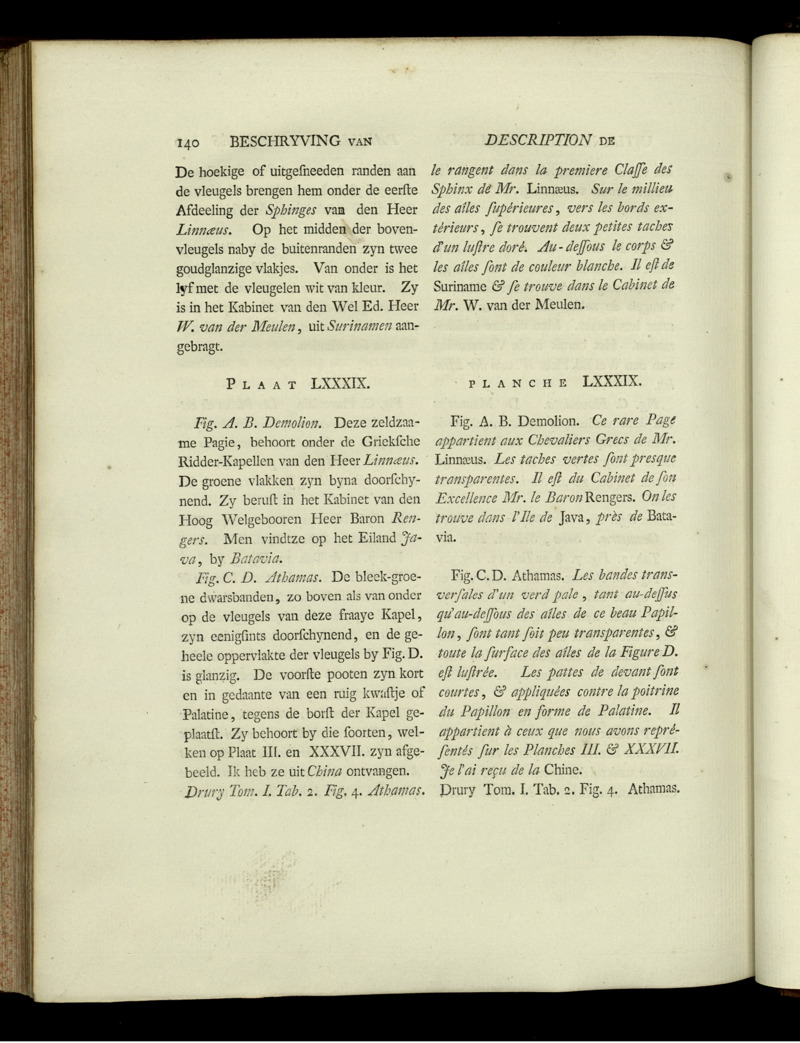 |
| Cramer's paper describing the demolion species. Credit: Göttinger DigitalisierungsZentrum |
[7.3] Type Specimen
According to the definition given by the Western Australian Museum, a type specimen is one that is used by taxonomists to describe a particular species, and these type specimens are normally maintained by universities or museums so scientists have easy access to them.[14]Papilio demolion demolion
Status: Syntype
Specimen Data: ST (coll. Rengers)[15]
Current Depository: Unknown
Locality/Country: Indonesia
[7.4] Phylogenetic Relationships
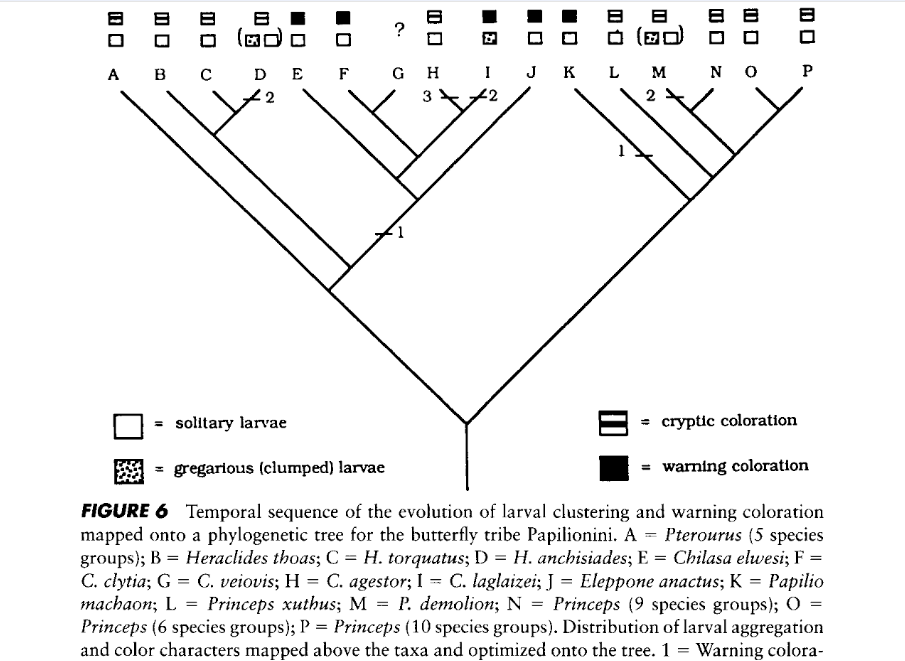 |
| Figure showing phylogenetic relations in the papilionini tribe. Credit: (Homoplasy: The Recurrence of Similarity in Evolution) |
The figure above analyses the phylogenetic tree for the butterfly tribe Papilionini with respect to certain traits such as having solitary larvae, cryptic coloration, gregarious larvae or warning coloration. From the figure, we can observe that Paplio demolion, represented by the letter M, is most closely related to Princeps group N as they both share the most recent common ancestor. Papilio demolion is also relatively closely related to Princeps groups O and P, and slightly more distantly related to Princeps xuthus, represented by the letter L.
 |
| Maximum parsimony tree from combined equally weighted data for Papilio. Credit: Oxford University Press (Obtained within limits of fair use as specified by OUP) |
[7.5] Synonyms of Papilio demolion
- Papilio demolion energetes Fruhstorfer, 1908
- Papilio demolion messius Fruhstorfer, 1908[16]
- ^ 1. Butterflies of Australia. URL: http://en.butterflycorner.net/Papilio-demolion-Banded-Swallowtail.971.0.html (Accessed 5 November 2016)
- ^ 2.Butterflies of Singapore: Life History of Banded Swallowtail by Horace Tan, 22 December 2012. URL: http://butterflycircle.blogspot.sg/2012/12/life-history-of-banded-swallowtail.html (Accessed 5 November 2016)
- ^ 3. Butterfly Circle by Laurence G Kirton, 2008. URL: http://www.butterflycircle.com/checklist/showbutterfly/12 (Accessed 5 November 2016)
- ^ 4. Butterflies of Singapore: Life History of Banded Swallowtail by Horace Tan, 22 December 2012. URL: http://butterflycircle.blogspot.sg/2012/12/life-history-of-banded-swallowtail.html (Accessed 5 November 2016)
- ^ 5. An Introduction to Butterfly-Plant Relationships at Sungei Buloh Nature Park by Khiew Sin Khoon, August 2000. URL: http://mangrove.nus.edu.sg/pub/wetlands/text/00-7-2-2.htm (Accessed 5 November 2016)
- ^ 6. Courtship Behaviour of Butterflies by Lena Chow and Khiew Sin Khoon, November 2013. URL: http://www.besgroup.org/2013/11/18/courtship-behaviour-of-butterflies/ (Accessed 5 November 2016)
- ^ 7. Samui Butterflies by Les Day. URL: http://www.samuibutterflies.com/insects/butterflies/papilionidae/papiliodemoliondemolion/ (Accessed 6 November 2016)
- ^ 8. Wallace, A.R. (1869) The Malay Archipelago. Publisher: Eric Oey. Page: 215
- ^ 9. The Swallowtails of Singapore by Khiew Sin Khoon. URL: http://the-butterfly675.blogspot.sg/2008/04/the-swallowtails-of-singapore.html (Accessed 7 November 2016)
- ^ 10. Nature Society's Observations by Nature Society, 20 July 2016. URL: http://naturewatch.org.nz/observations/3713554 (Accessed 7 November 2016)
- ^ 11. Definition of Subspecies by Merriam-Webster Dictionary. URL: http://www.merriam-webster.com/dictionary/subspecies (Accessed 7 November 2016)
- ^ 12. Phylogenetic Tree by Biolib.cz. URL: http://www.biolib.cz/en/taxontree/id310789/ (Accessed 7 November 2016)
- ^ 13.Species Taxon Summary by Göttinger DigitalisierungsZentrum. URL: http://www.animalbase.uni-goettingen.de/zooweb/servlet/AnimalBase/home/speciestaxon?id=27831 (Accessed 7 November 2016)
- ^ 14. 'What is a type specimen?' by Mark Harvey and the Western Australian Museum, 2012. URL: http://museum.wa.gov.au/explore/blogs/museumcollections/what-type-specimen (Accessed 6 November 2016)
- ^ 15. Haeuser, C. L., Holstein, J. & Steiner, A. (2012): The Global Butterfly Information System. URL: http://www.globis.insects-online.de/ Last updated 08.04.2012 (Accessed 6 November 2016)
- ^ 16. Catalogue of Life: 2012 Annual Checklist by Haeuser, C. L., Holstein, J. & Steiner, A., 2012. URL: http://www.catalogueoflife.org/annual-checklist/2012/details/species/id/6107990/synonym/6108793 (Accessed 8 November 2016)

